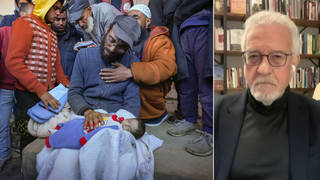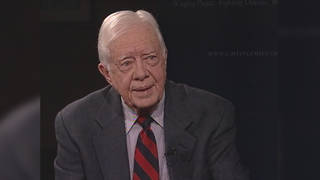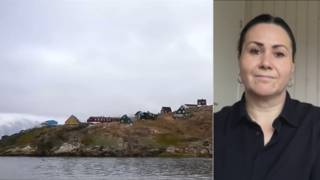
Related
Topics
Guests
- Norm Stamperformer Seattle police chief. He is author of Breaking Rank: A Top Cop’s Exposé of the Dark Side of American Policing.
Medical examiners in California say they have positively identified the body of former Los Angeles police officer Christopher Dorner, the man authorities say killed four people over the past two weeks in a campaign of terror against the LAPD. Dorner’s body was found in the burned-out ruins of a California mountain cabin ending the most extensive manhunt in California’s history. Questions are being raised over whether police intentionally set his hideout on fire after police officials confirmed the use of incendiary tear gas. An audio recording from a police scanner appears to show officials from the San Bernardino County Sheriff’s Department planning to deploy “burners.” In another recording that was aired live on the television station KCAL, a police officer can be heard in the background shouting, “We’re going to burn him out,” and “Burn it down!” We are joined by former Seattle Police Chief Norm Stamper, who says, “Whether it was intentional or not, a very predictable outcome of deploying seven burners in what appears to have been a wooden cabin would predictably leave it in rubble.” [includes rush transcript]
Transcript
JUAN GONZÁLEZ: Medical examiners in California say they have positively identified the body of former Los Angeles police officer Christopher Dorner, the man authorities say killed four people over the last two weeks in a campaign of terror against the LAPD. Dorner’s body was found in the burned-out ruins of a California mountain cabin, ending the most extensive manhunt in California’s history. Dorner was chased into the cabin on Tuesday afternoon amidst a massive gun battle in which one San Bernardino County deputy was killed and another badly wounded. Police say the first shot—they first shot conventional tear gas into the cabin, but it failed to force Dorner to flee the house.
AMY GOODMAN: Authorities then shot flammable tear gas canisters into the cabin. The building soon erupted in flames and burned to the ground. Police had been alerted to Dorner’s possible whereabouts after he had broken into a nearby vacation home, tied up a couple there, and made off in their car. The couple managed to free themselves and alert authorities.
Questions are now being raised over whether police intentionally set the cabin on fire. An audio recording from a police scanner appears to show officials from the San Bernardino Sheriff’s Department planning to deploy “burners.”
MALE VOICE: All right, Steve, we’re going to go—we’re going to go forward with the plan, with—with the burner.
MALE VOICE: We want it, uh, like we talked about.
MALE VOICE: Seven of the burners deployed, and we have a fire.
FEMALE VOICE: Copy. Seven burners deployed, and we have a fire.
JUAN GONZÁLEZ: Police say the phrase “burner” referred to a grenade-like canister containing flammable tear gas. In another recording that was aired live on the TV station KCAL, a police officer can be heard in the background shouting, “We’re going to burn him out,” and “Burn it down.”
KCAL REPORTER: We do know that authorities were searching for a man in a Dodge pickup truck.
POLICE OFFICER: The last location of the suspect [inaudible].
POLICE OFFICER: We’re going to [bleep] burn him out!”
POLICE OFFICER: [inaudible] I don’t know.
POLICE OFFICER: Let’s burn it down.
POLICE OFFICER: Get going, right now!
POLICE OFFICER: Burn this [bleep]!
KCAL REPORTER: Police officers, understandably, upset.
AMY GOODMAN: On Wednesday, San Bernardino County Sheriff John McMahon admitted his deputies deployed the highly flammable hot gas canisters, but denied they intentionally started the fire.
SHERIFF JOHN McMAHON: I can tell you that it was not on purpose. We did not intentionally burn down that cabin to get Mr. Dorner out. The tear gas canisters that we used—first off, we used a presence when we showed up. Secondly, we used a cold tear gas. Then we used—the next tear gas was that that was pyrotechnic, does generate a lot of heat. We introduced those canisters into the residence, and a fire erupted.
AMY GOODMAN: We asked a representative from the San Bernardino sheriff’s office to join us, but they declined. But for more, though, we are joined by two guests: Norm Stamper, former police chief of Seattle and the author of Breaking Rank: A Top Cop’s Exposé of the Dark Side of American Policing, and in Washington, D.C., we’re joined by Radley Balko, a senior writer and investigative reporter for The Huffington Post. He’s author of the forthcoming book, Rise of the Warrior Cop: The Militarization of America’s Police Forces, which is due out in July.
We welcome you both to Democracy Now! Chief Stamper, why don’t we start with you, former Police Chief Stamper? Can you react to how the San Bernardino Police Department dealt with—with Dorner, the burning down of the cabin? What is your understanding of what happened and what was used?
NORM STAMPER: Well, I think the sheriff has articulated what might be seen as escalating levels of force. He started with the mere presence of the deputies, presumably surrounding that cabin. Then they used cold tear gas, so-called cold tear gas. And then they went to the pyrotechnic version, or the incendiary version of CS gas. And whether it was intentional or not, a very predictable outcome of deploying seven burners in what appears to have been a wooden cabin would predictably leave it in rubble.
AMY GOODMAN: And what’s your assessment of that? Do you think they should have done that?
NORM STAMPER: You know, I’m not going to second-guess it, but I think over the days and weeks ahead it’s imperative that that agency and the rest of the country, all of us riveted by what happened there, understand what decisions were made and why they were made. I can tell you that I am troubled by the use of incendiary chemical agents. By definition, these pyrotechnic versions of tear gas start fires. They are intended for outdoor use. They are not intended for contained structures, particularly wooden structures.
Another observation that I think bears real careful examination, and that is the almost hysterical command to use those burners. The expletives that were used begin to suggest that emotion rather than professionalism, rather than a calm and deliberate approach to extracting Mr. Dorner, if in fact that was possible, were simply not used.
AMY GOODMAN: We’re going to go to a break, and then we’re going to return to this discussion. Norm Stamper is former Seattle police chief, author of the book Breaking Rank. And we’re also going to be joined by Radley Balko, who is writing the book Rise of the Warrior Cop. After that, we’ll be joined by Ben Jealous, president and CEO of the NAACP, who will talk about President Obama’s State of the Union address proposal in dealing with obstacles to voting. This is Democracy Now!. Back in a minute.













Media Options